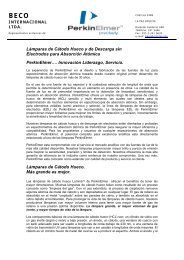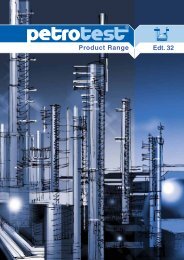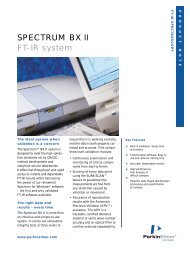General Catalogue Chemistry - BECO Internacional LTDA.
General Catalogue Chemistry - BECO Internacional LTDA.
General Catalogue Chemistry - BECO Internacional LTDA.
You also want an ePaper? Increase the reach of your titles
YUMPU automatically turns print PDFs into web optimized ePapers that Google loves.
laboratory gases<br />
Compressed gas bottles<br />
There are three ways of obtaining the gases<br />
required for common laboratory experiments:<br />
· One can make small quantities oneself by<br />
means of chemical reactions, e.g. zinc with<br />
hydrochloric acid as a demonstration of hydrogen,<br />
in a gas generator.<br />
A suitable device for this is the gas generator<br />
according to MAEY, equipped with either a<br />
tube with sintered disk or a dropping funnel,<br />
permitting gas generation from either solid<br />
Gas bottle<br />
Cat. No. Type of gas Colour Gas content*<br />
661 010<br />
661 011<br />
661 012<br />
661 013<br />
661 014<br />
hydrogen red 2,0 m3 oxygen blue 2,0 m3 carbon dioxide gray 7,5 kg<br />
nitrogen green 2,0 m3 helium gray 2,0 m3 * with reference to standard temperature and pressure<br />
661 019<br />
Trolley<br />
For one gas bottle 10 l,<br />
with safety chain<br />
280 LEYBOLD DIDACTIC · GENERAL CATALOGUE CHEMISTRY<br />
or liquid materials. Self-production<br />
of gases is recommended only when occasional<br />
small quantities (up to approx. 100 ml)<br />
are required.<br />
· Smaller quantities of gas in gas cans. This type<br />
of gas supply is ideal for small requirements of<br />
pure gases, which can be drawn from the easyto-use<br />
aluminum containers without preparation.<br />
With a volume of 1 l, the gas cans contain<br />
between 12 1 (compressed gas) and 200 1<br />
(liquefied gas).<br />
Our gas bottles are approved by the West German<br />
Technical Inspection Agency (TUeV);<br />
additionally, the hydrogen bottles are also ultrasonically<br />
tested. The required hardness certification<br />
has been issued (manufacturer's certificate<br />
supplied).<br />
The gas bottles are supplied full and are property<br />
of the school (not returnable bottles). They can<br />
be refilled by local suppliers. When necessary,<br />
these will also carry out any testing of the bottles<br />
required by local regulations.<br />
Please note that gas can only be withdrawn using<br />
suitable pressure reducing valves. In addition,<br />
the gas bottles must be secured against falling<br />
over, and must be removed from the classroom<br />
after the lesson using suitable (tip-proof) trolleys<br />
according to applicable laboratory regulations.<br />
Gas bottle<br />
Steel, according to DIN, TÜV-tested, with valve<br />
protection cap and base. The gas bottle is<br />
labelled with the name of the school or institution.<br />
Filled.<br />
Volume: 10 l<br />
Filling pressure: max. 200 bar<br />
Length: 85.5 cm<br />
Diameter: 14 cm<br />
Weight empty: approx. 18 kg<br />
661 020<br />
Trolley<br />
For two gas bottles 10 l,<br />
with safety chain.<br />
· Larger gas quantities in 10 l gas bottles (2 m 3<br />
content). This is the most cost-effective way of<br />
covering large gas requirements. It is primarily<br />
recommended for the supply of the most commonly<br />
used gases, hydrogen and oxygen






